Taming tips
From Hamster Central WIKI
by forum members Pophammy and Souffle
Some of the most common problems encountered by hamster owners old and new, are those associated with taming. Many factors influence how easy it is to tame a hamster, including source, cage type and species, so we would like to give a broad set of guidelines on taming in this article which we hope will help answer most questions and benefit most people.
These opinions on taming are our own and have always worked for us over many years and many, many hamsters. Others may have different ideas and we hope everyone will make their own choices from the information available and successfully tame their hamster, for a tame hamster is a pleasure to own and has a much richer life, where it can enjoy the freedom of outside play with its owner and the pleasure of being stroked and petted.
Firstly the source of the hamster plays a big part in how easy it is to tame. If possible it is best to get a pet from a good hobby breeder, particularly if it is for a child. Breeders will handle babies from around 2 weeks of age so they become used to it at an early stage.

Many pet shop hamsters come from large, commercial breeders and have never even seen a human, never mind been handled before coming to the shop.
Secondly, the species. This is of lesser importance with adults but with children the larger Syrian Hamster tends to be easier for them to handle and also slower and more placid as a rule. Dwarf hamsters such as the Winter White Hamster and Dwarf Campbells Hamster are quite speedy and can be difficult to catch for children, but do tame well, especially of they are obtained from a breeder who has handled them young. The Chinese Hamster is quite small but again will tame well. The Dwarf Roborovskis Hamster is really only suitable for adults or older children as they are very small and the speediest of all.
The cage that the hamster is kept in when starting taming is also very important. We would recommend that until a hamster is tamed it should not be kept in a cage with numerous tunnels and hidey holes such as a rotastack. Pretty though they may be and very tempting to children they are so difficult to get a nervous hamster out of that many kept in them remain untamed as the owners simply cannot get them out. It is best to start your baby off in a small, highly accessible cage or bin type cage; it can easily be moved once it is tamed.
Now for the taming itself. When you first bring your new pet home you should have the cage all set up and ready. Put in the cage some ripped up tissue that you have put your scent on by rubbing it over your hands and skin. This way the hamster gets used to your smell in the cage. Replace the scented tissue or add another sheet daily for the first few weeks.
For the first day leave your hamster quietly to settle in. On the next day start the taming. Some people like to give longer but personally we do not find this is of any benefit. Wait till you see the hamster up and about and start by talking gently to it, sitting beside the cage and effectively crooning. It does not matter what you say as long as it is calm and soothing. Recite a nursery rhyme if you like! When the hamster seems calm and happy in your presence take the cage to either the floor in a secure area such as a hall, or a large bed. Remove the top and have either an ice-cream tub or a hamster play ball ready. Offer it a small treat.
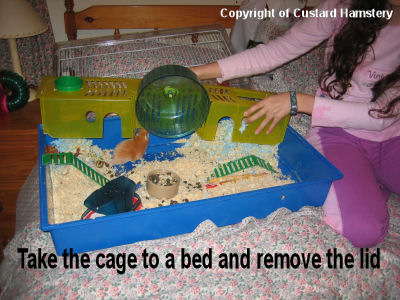
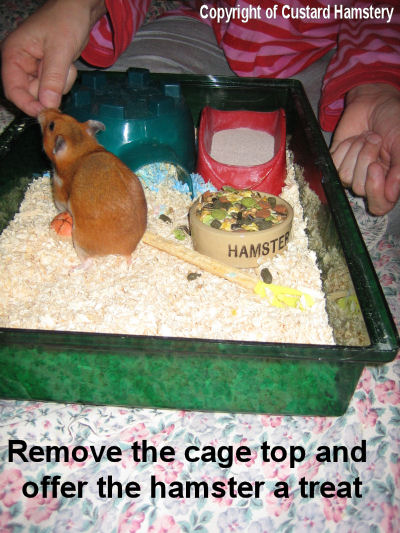
Herd the hamster in to the container using the lid. Maybe put a treat in the box such as a yogurt drop or a raisin so they associate the box with something nice.
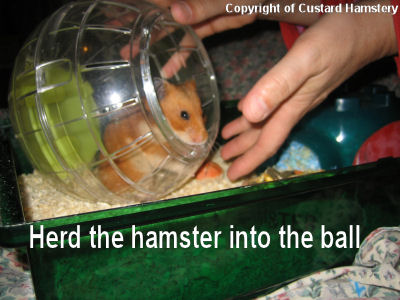
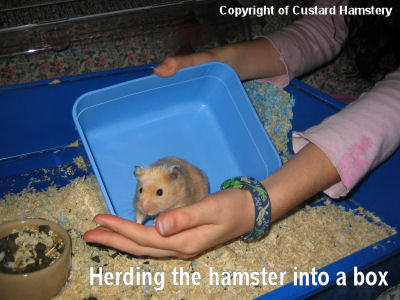
Take the container on to your lap and open the lid. Lay it on to your lap and allow the hamster to climb out. If it will not you may need to tip it gently out. Try and have a towel on your lap so that if you open your legs a bit then there is a safe place for it to sit.
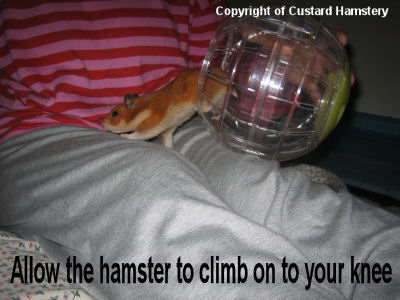
Gently stroke the hamster along its back, then put one hand on either side of its body and scoop it up into your hands.
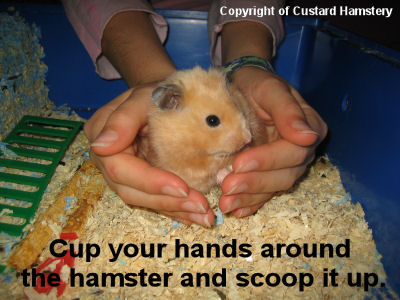
Keeping the hamster very low over the bed or lap, make a sort of tunnel with your hands, and allow it to run from hand to hand for as long as you can, making sure it can feel your hand round its body all the time. Be warned: at first hamsters are very, very fast and your hands will need to keep up with them. Do not be surprised if it jumps, runs very fast, pees and poops on you, or tries to nip. These are all normal reactions and will stop as taming progresses. If it does try to nip blow softly on the nose and say ‘no’ in a firm voice. Hamsters will normally learn quickly. Do not present a pointed finger to the hamster as it can easily get its teeth round this to nip. Instead offer a fist for it to sniff. Try and keep calm yourself and not shriek or panic as hamsters will sense this. If you repeat this several times a day your hamster should become tame and you will be able to start allowing it to sit on your shoulders and chest and start supervised exploring of the bed, sofa and anywhere you like.
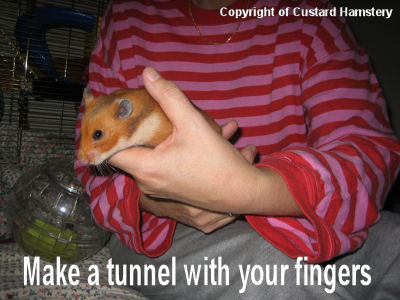
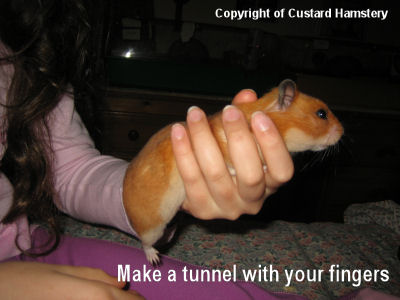
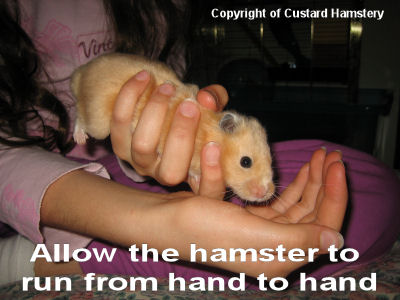
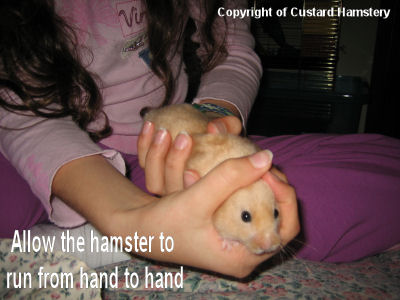
Many people like to have a playbox, where they can get their hamsters out and tame them from that easily, but they must always be supervised as they are very agile climbers!
Ensure that children are supervised at first when handling the hamster, as a fall or fright can injure the animal or make it very timid and set taming back considerably. Teach them to always keep the hamster low in case it falls and to be calm and quiet in its presence. They will soon be captivated by its antics.
A good method with children especially is to get them to sit with their feet sole to sole. The hamster can be popped in the paddock in the middle. The hamster will inevitably try and climb over their legs and they can calmly lift it back into the paddock.
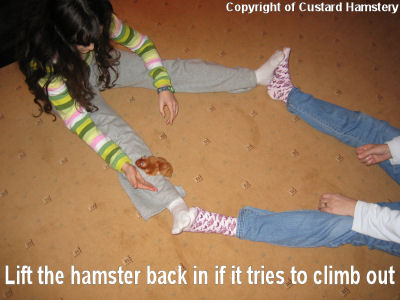

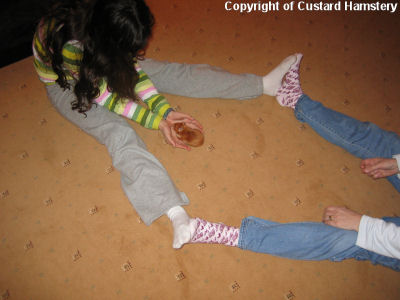
Once your hamster is beginning to tame well, and importantly if it is a child’s pet, it is advisable for you to teach it to get up or to be taken from its cage at a time suitable for the family. If you did not do this then some children would never see their pet. It is a good idea when you feed the hamster to make some sort of signal noise. We run our fingers over the bars and say ‘come on hammies’. They will start to associate this with food and come out when called. If they do not come out them you will need to take the cage to a low, safe area and encourage them out. At the end of taming we expect to be able to put our hand safely into the nest without being bitten.
This all takes time, so have patience, be firm and consistent and you will succeed. You must handle your hamster regularly. Do not expect it to remain tame if you only handle it once in a blue moon when it suits you. Once tamed the animal deserves the enjoyment of free play that you have introduced it to. Be respectful of how your hamsters feel and respond as they too can have off days just like us. They may not want to be disturbed as often as they get older or may just like to curl up on your lap. Remember never to handle your hamster if you have a cold or flu as they are susceptible to catching these viruses from humans.
Most hamsters will tame easily using this technique but there are a few that we have had to ‘force’ tame. These are usually animals which have had a bad start, a fright, or are much older untamed hamsters, and to get the most from life we feel it better to use an intensive taming technique. Basically we would use the same process as described but if necessary would wear gardening gloves initially in case of bites and also work in a very secure area over a towel as weeing is common with a nervous hamster. The intensive handling would be carried out at least 3 times a day and we do not put the hamster back in its cage if it tries to bite. Use the blowing technique and continue handling.
We hope you have found this of help in taming your hamster. Believe in yourself, have confidence and you can do it. From experience we can tell you that a little nip really doesn’t hurt!
If you have any specific questions feel free to contact us at [email protected] and we will do our best to help.

